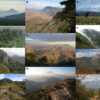The Earth’s deep-sea trenches are some of the least explored places on Earth—as they are very difficult to access, are pitch black and the pressure is extremely high. Collecting samples and making reliable measurements of the processes that regulate the turnover of organic material in the deep is therefore difficult.
In recent years, however, researchers from the Danish Center for Hadal Research (HADAL) at University of Southern Denmark have carried out a number of expeditions to deep-sea trenches.
They have developed and applied sophisticated underwater robots, and they have demonstrated in several published studies that the steep deep-sea trenches accumulate various material including organic carbon that ends up at the bottom of the trenches.
The bottom of a deep-sea trench can therefore be a veritable deposition hotspot for microbial life forms that converts the material.
Carbon accumulates in the trenches
In three recent studies, the researchers report that hard-to-decompose organic carbon, including so-called black carbon, accumulates in large quantities at the bottom of the trenches.
Black carbon consists of particles formed during burning of fossil fuels, wood and forests; activities that also lead to the release of CO2. The occurrence of black carbon is thus an indicator of the extent of fossil burning. The particles themselves can also contribute to warming, as they are carried by wind and weather to ice-covered areas, e.g. polar regions, where they settle on ice and snow, increasing heat absorption and thus the melting.
“And now we see that large amounts of black carbon end up at the bottom of deep-sea trenches,” says Ronnie N. Glud, professor and head of the Danish Center for Hadal Research.
Samples from more than six kilometers depth
More concretely, the research team has calculated that every year, somewhere between 500,000 and 1,500,000 metric tons of black carbon is stored in the hadal deep-sea; that is the part of the seabed that lies at a depth of more than six kilometers.
In comparison, 6,600,000—7,200,000 metric tons of black carbon are emitted annually from the burning of fossil fuels.
The researchers base their calculations on sediment samples that they have



